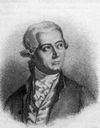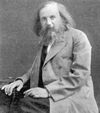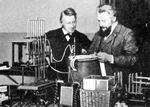
> Quality
of Chemical Measurements
> Europe's Favorite Chemists?
> News and Notices
> Symposia Reports
> New Projects
> Awards and Prizes
> New Books
> Commissions Reports
> Conference
Announcements
> Conference Calendar
Chemistry International
Vol. 23, No. 1
January 2001
Europe's Favorite Chemists?
by Prof. Colin Russell*
Antoine Lavoisier
Jöns Jakob Berzelius
Dmitri Mendeléev
Justis Liebig
Jacobus van't Hoff and Wilhelm OstwaldIntroduction
FECS Millennium Project
Working Party for the History of Chemistry
Final ListChoosing Europe’s Top 100 Chemists: A Difficult Task
The millennium bug does not only bite computers. Human beings are susceptible to it, too.
Occasionally, this bug may lead to bizarre behavior patterns that have only one thing in common: an irresistible desire for some kind of celebration in the year 2000. Often, there is only the foggiest idea as to what is actually being celebrated. That it is notionally 2000 years since the birth of Christ is quite forgotten in general. An additional irony lies in the fact that recent evidence from history, archaeology, and astronomy suggests a birthdate about seven years earlier, so the real millennium came and went unnoticed in the early 1990s.
However that may be, the grand spirit of revelry and bonhomie cannot be quenched by such mundane considerations, and celebration there shall be. Nor are societies to be left behind in the general euphoria
In 1998, the Federation of European Chemical Societies (FECS) proposed to celebrate in its own way and to mark the occasion by proclaiming to the world names of the top 100 European chemists. Inclusion in this hall of fame would do little for the individuals concerned for the simple reason that they all had to be dead. However, it might gladden the hearts of surviving relatives of a few. It would minister to the pride of nations whose sons and daughters were so honored, and (if handled properly by the spin doctors) could be a useful reminder to the general public of just how much they owe to the chemists of Europe. And that would be a very good thing, indeed! The only problem was this: How on earth does one try to establish such a list and get general agreement for it? Ask 20 chemists for a short list of their own candidates and you will end up with 20 different answers. Try to be objective and you just give up for lack of agreed criteria. Thus, quantitative data gleaned from citation indexes may testify to volume but not quality of a chemist’s work. Being a Nobel prizewinner in chemistry was a possible criterion, but there were not enough of these from Europe–Nobel prizes only started in 1901–and all Nobel prizewinners are not equal. There are no sales figures to help us establish which releases are "top of the pops" (and no comparable audience reactions, come to that!).
So what do you do? You ask the public.
In this case, one can hardly inquire of the whole population of Europe. Instead, FECS made the sensible decision to devolve the early stages of nomination to the member societies. Each was asked to provide its own list. It was suggested that working parties should be established, and guidelines were offered. Thus, persons proposed should have transformed chemical science and exerted a worldwide influence. They should have conducted the major part of their work in Europe, and so on. The surprising feature of this millennium celebration was that the period concerned stretched back not 2000 or even 1000 years, but a little over 200. At one stage, it was suggested that the Chemical Revolution (whatever that was) should be a good starting point.
This milestone seemed generally understood to be the reforms associated with Lavoisier at the end of the 18th century, though in practice the list included a few who predated–or even opposed–this Chemical Revolution.
So, at a stroke, chemical giants such as Paracelsus, Glauber, van Helmont, Hales–and even Robert Boyle–were excluded automatically. And there were certainly no alchemists. Still, rules are rules, and most countries produced a response broadly on the agreed lines.
The result was a spectacular demonstration of variable response. Eight countries did not reply at all Whereas most that did (including the United Kingdom) made an effort to be fair to everyone and to supply an international list, the names provided by no fewer than 10 countries consisted exclusively of their own nationals. This possibility was quite unexpected, but not formally excluded by the rules. Possibly, these respondents thought that everyone would play the game this way.
Or maybe they just felt the need to keep their own end up. But if all had done this, it is hard to see how a reasonable list could emerge, because each respondent was given equal weight in the analysis. It would have meant the same number of names from (say) France, Slovenia, Italy, Portugal, and Ireland. Therefore, for the early compilation stages, it seemed quite fair to set aside the submittals from these 10 societies. That left 20 others who had all tried to be genuinely international. Gratifyingly, these included some of the smaller societies, such as those from Finland, Slovenia, and Cyprus.
[More]
* This article by Prof. Colin Russell (Department of History of Science and Technology, Open University, Milton Keynes, England MK6 7AA, UK) was commissioned by Chemistry in Britain and published by that magazine in Vol. 36, pp. 50–52, February 2000
The list of Europe’s 100 distinguished chemists was compiled by the Federation of European Chemical Societies (FECS). We thank Prof. Russell, Chemistry in Britain, and FECS for permission to reproduce the article in full here. Thanks also to Prof. Lauri Niinistö of the Helsinki University of Technology, Laboratory of Inorganic and Analytical Chemistry, for providing the illustrations and photographs.
News
and Notices - Organizations and People
- Standing Committees
Divisions
- Projects - Reports
- Publications - Symposia
- AMP - Links
Page last modified 20 December 2000.
Copyright © 1997-2000 International Union of Pure and Applied Chemistry.
Questions or comments about IUPAC, please
contact the Secretariat.
Questions regarding the website, please contact [email protected]





